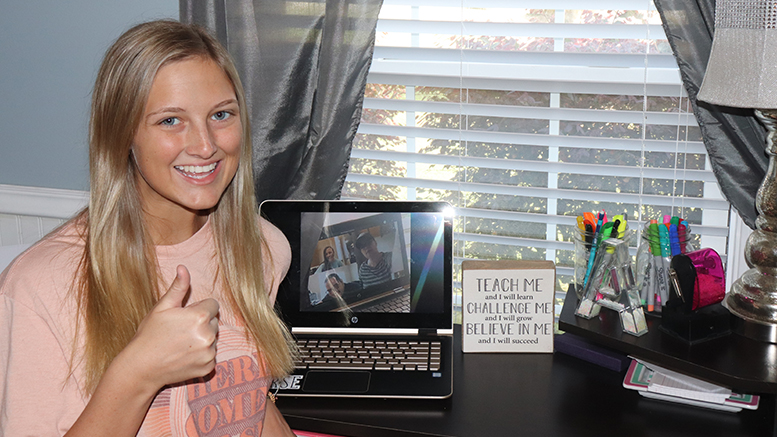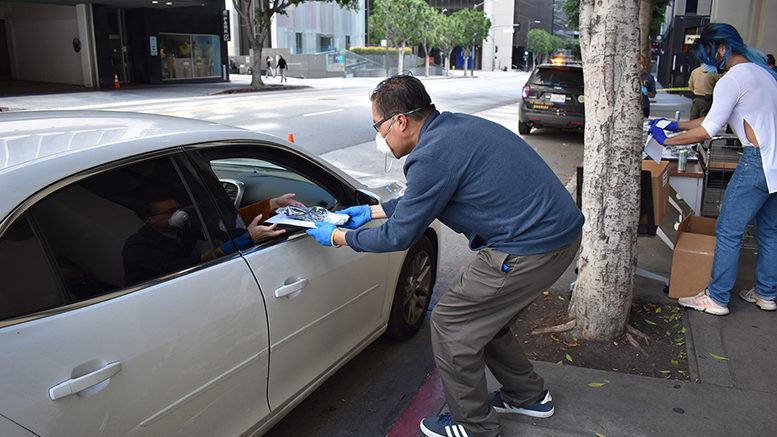Faced with closed campuses due to the coronavirus pandemic, community colleges are undertaking massive efforts to move classes online, train faculty and make sure everyone has access to computers and the internet.
At Montgomery College in Maryland, 20,000 students were already enrolled in distance-learning courses, but many instructors had no experience with remote teaching, said Michael Mills, vice president of e-learning, innovation and teaching excellence.
Those teachers spent spring break learning how to convert face-to-face classes to remote settings on the Blackboard platform.
“Surprisingly, things seem to be going really well,” Mills said last Monday, the first day all classes went remote.
“What we’ve been telling faculty is, ‘You’re not expected to create a totally online course. We want you to connect with students any way possible,’” he said. “This doesn’t have to be perfect.”
Faculty can prepare their instruction one week at a time, and they can conduct synchronous or asynchronous classes.
Some faculty members have all their students login in realtime, some post content on Blackboard and have students respond on a chat platform or via email, and others conduct an asynchronous class while offering virtual office hours. Teachers with webcams are interacting with students on Blackboard Collaborate or Zoom.
While some instructors have found switching to remote teaching a challenge, “they are also the ones who are embracing it,” Mills said. “They know it’s the new normal. They want to be there for their students.”
He added: “While it’s not ideal, people adapted to the idea that this is the way it’s going to be for the rest of the semester.”
Mills expects that the conversion to digital learning will have a lasting impact. When the coronavirus emergency is over, he thinks more students will sign up for online classes. Faculty also will become more willing to innovate, try different tools and take chances they weren’t previously willing to take, he said.
A monumental shift
The Los Angeles Community College District (LACCD) plans to start online instruction at all nine of its colleges on March 30.
“This is a huge coordinated effort by the district in consultation with the colleges and faculty,” said LACCD spokesperson William Boyer. “We are in an unprecedented, monumental shift to online learning for as much as 95 percent of classes.”
In recognition of the tremendous amount of work that had to be done, the district basically shut down instruction on March 14, Boyer said. Spring break was extended to train faculty in the Canvas online learning platform, distribute laptops and notify everyone of the change to remote classes.
A small percentage of classes that can’t convert to a remote format are on hold until May 4. Examples include programs for electrical line workers, where students have to climb a utility pole, and theater production, where students are graded on how they light a stage.
Faculty training
Wallace Community College (WCC) in Alabama is also ready to start remote learning when students return from spring break on March 30. Many teachers already had distance-learning experience with Blackboard, so much of the training was focused on upgrading their skills, said Leslie Reeder, dean of instruction.
With regard to career and technical courses, as much as possible was put online, including live videos with demonstrations. All clinicals are suspended, and anything that must be done in person will be delayed, Reeder said.

School officials are reaching out to all students “in every possible way” to see if they have computers and internet access, she said. Local cable companies are providing 60 days of free hotspot access for students.
“These are certainly unprecedented times, but they offer us a unique opportunity to rise to the occasion and fully live out the mission of our calling as educators,” said WCC President Linda Young.
Building on experience
Remote instruction started March 23 at Sinclair College in Ohio, with more than 2,000 courses converted.
“More than 500 of our faculty and staff have been working around the clock to make this transition happen,” said President Steve Johnson.
That process was a little easier because Sinclair already had a highly rated online program and widespread use of eLearn, said eLearning Dean Christi Amato.
There were no widespread glitches due to Sinclair’s existing capacity, Amato said, “but we did have students and faculty report ‘Zoom fatigue.’ It was a tough transition from seeing and interacting with people in-person every day, to spending all day in virtual meetings.”
Training faculty
Spring break at Lone Star College (LSC) in Texas was extended until April 13 to help faculty adapt courses to remote formats, said Kyle Scott, vice chancellor of strategic priorities.
Scott said Lone Star is planning for three possible scenarios:
- Reopen for regular face-to-face classes on April 13.
- Reopen in mid-May.
- Stay closed until fall.
If its campuses reopen on April 13, LSC will add more course sections to maintain social distancing in classrooms.
In the meantime, faculty is being trained and getting certified as online instructors using the D2L (Desire2Learn) platform. The Kingwood Campus is farthest along in the process, with 396 of its 400 full-time faculty members trained to teach online.
“We learned a lot from our experience with Hurricane Harvey in 2017,” Scott said. “The Kingwood campus was decimated, and all courses were delivered online. So, there’s a history of that capability at Kingwood.”
“Some accreditation agencies are allowing us to move career and technical courses online and some aren’t,” he added. “Right now, everybody is trying to be as creative as possible and looking for a solution without compromising our standards and safety.”
A moving target
About 20 percent of full-time enrollment at Arapahoe Community College (ACC) in Colorado was already online before the pandemic, said Rebecca Woulfe, vice president for instruction and provost.
“Community colleges are well-positioned to do this, more so than four-year colleges. We had the tools in place. We had the skills in place,” she said.
Every ACC teacher already had a D2L shell and was required to use it to post their grade book, syllabus and faculty contact information. Still, converting the whole college to remote learning took some work, and the college gave students an extra week of spring break to allow instructors time to get their courses ready. Remote learning starts college-wide on March 30.
The American Association of Community Colleges will host a free webinar March 31 at 2 p.m. ET to review what community colleges can expect from the stimulus legislation that the president signed on Friday.
Arapahoe had initially planned to continue some labs and workforce programs in person next month with social-distancing rules in place, but the Colorado governor ordered everyone in the state to stay home as of March 26.
“So now we’re on plan C,” said Woulfe, adding that some students will get an “incomplete” grade until the college reopens and hands-on learning resumes.
Many instructors, however, plan to use virtual simulations for science labs, and one instructor set up a lab at home in the kitchen. Some are recording videos of labs and sharing them with teachers at other community colleges in the state via D2L Brightspace.
Woulfe said that she expects a fair number of nursing students will get an incomplete grade if they can’t finish their clinicals. State nursing directors reached out to the state board of nursing to request a waiver on clinical hours but hasn’t heard back yet.
“The Catch 22 is that the state needs these students to complete and start working,” she said.
Providing resources
ACC distributed 17 laptops to teachers and 150 iPads to students who don’t have computers at home. It also purchased Verizon hot spots to loan to students. Comcast is providing free internet to those in need.
The college used Navigate by EAB and phone calls to survey students on their needs – food, housing, technology or lack of confidence in moving online – and reached out to those who need assistance. Anyone who had accessed the college’s food pantry was given a grocery gift card.
ACC is also making sure students are aware of online resources, including extended hours for the Tutor Me program, the online writing center and the math support center on Zoom.
Online buddies
All spring term courses at Portland Community College (PCC) in Oregon have shifted to remote operations using the D2L Brightspace platform, said Katy Ho, vice president of academic affairs. Interactions among faculty and students are held on Google Hangouts.
A few programs where that isn’t possible, such as welding, are paused for the rest of the term with the hope that they can resume face-to-face instruction in the summer, she said.
Faculty members who are more comfortable with remote learning formed peer support networks and were paired with a less-experienced “online buddies,” Ho said. “Faculty have been incredibly gracious in helping each other.”
She added that professional development sessions conducted last year on making the most of online learning are being ramped up to ensure there is “inclusive engagement in an online setting.”
PCC provided grants from its emergency funds to help students purchase laptops and reached out to community organizations and business partners to help students access free or reduced-cost internet connections, said Heather Lang, interim vice president of student affairs
“We’ve been able to pivot quickly,” she said. “Advising services have already gone remote, and career and academic counseling is provided through a telehealth model.”
Services that previously were provided at resource centers on each campus – such as Veterans Resource Centers, Multicultural Centers and Queer Resource Centers – are being transformed into virtual communities, Lang added.
Remote advising
In Michigan, Lansing Community College had planned and trained faculty for distance learning for several weeks and transitioned to a fully online college March 18.
Courses that can’t be taught remotely, such as digital audio production, dental hygiene and massage clinic, were suspended.
“Everything is going well so far,” said Provost Sally Welch.
“Our biggest unknown,” Welch continued, was the extent to which students didn’t have computers or internet access. LCC loaned 700 laptops to students, along with Jetpack mobile hotspots for faculty.
The college implemented more online supports for students, such as virtual chat services, online access to success coaches and the tutoring center, and a virtual chat service for the library.
Faculty already had D2L shells in place, the college had a robust array of open educational resources and Cengage is temporarily giving students free access to textbooks, so there was minimal cost, Welch said.
While the technical aspects of distance learning are working out, Welch is concerned about the mental impact on students and faculty.
“They’re missing out on the social impact of teaching. They’re scared about the virus,” she said. “We’re working really hard to communicate with students as much as we can,” including “reach outs,” where academic success coaches are checking in with students.
“Everybody is working as hard as we can to make sure students are supported,” Welch said.

